Enterprise Library—数据访问程序块
Enterprise Librar—数据访问程序块
前言
当我们在编写程序的时候,我们难免要对数据库进行访问,在进行数据库访问的时候,我们肯定会遇到下面的问题:
1) 重复代码——Writing (cutting and pasting) the same data access code throughout your data access layer
2) 硬编码——Matching stored procedure parameter definitions with the calling application code
3) 对连接池的担心——Wondering if your code is properly closing connections
4) 自己写组件简化对存储过程的调用——Writing a component to make it simpler to call stored procedures
5) 如何存储连接串——Wrestling with where/how to store connection string information
当然,这些问题我们自己也是可以解决的,但是数据访问程序块给我们提供了这些功能,我们为什么不用呢?
一、我们的目标
1) 一种简单有效的方法——A simple and efficient way of working with commonly used databases
2) 多种数据库之间的透明——Transparency when developing for multiple types of databases
3) 逻辑和物理数据库的“松耦合”——A way to place an indirection between a logical database instance and a physical database instance
4) 简单的校验方式——An easy way to adjust and validate the database configuration settings
二、Data Access Application Block能够做什么
1) 提供最佳实践–Provides access to the most often used features of ADO.NET with applied best practices
2) 改善一致性–Write code that works against multiple database brands(caveats apply!)
3) 改善安全性–Leverages the configuration application block to securely store connection strings
4) 改善易用性–Easily call a stored procedure with one line of code
三、设计Data Access Application Block
数据访问程序块要达到的目标:
1) 集成执行数据库访问的逻辑
2) 排除常见的代码错误,比如连接失败
3) 减轻开发者为常用的数据访问写同样的代码
4) 减少了一般代码的书写
5) 像.NET的数据访问架构向导一样,为数据访问集成最好的实践
6) 尽可能地使数据访问程序块的功能适用不同的数据库
数据访问程序块中,各个类之间的关系如下: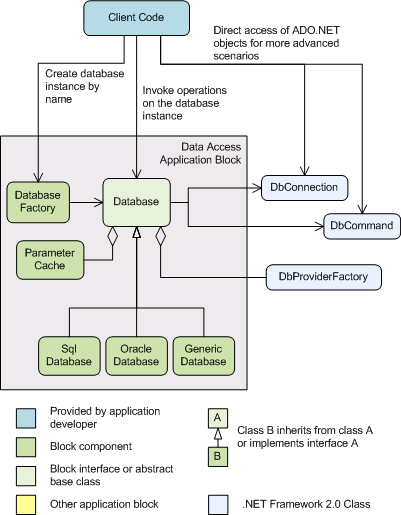
四、开始实践
终于知道数据访问数据块是做什么的了,废话少说,开始我们的旅程。
1)新建一个Windows或Web应用程序,将Microsoft.Practices.EnterpriseLibrary.Common.dll和Microsoft.Practices.EnterpriseLibrary.Data.dll引用到项目中。
2)把下面的命名空间增加到文件的头部using Microsoft.Practices.EnterpriseLibrary.Data
3)看看下面的一段代码:
 Database db = null;
Database db = null;
 db = DatabaseFactory.CreateDatabase("QuickStarts Instance");
db = DatabaseFactory.CreateDatabase("QuickStarts Instance");


 int count = (int)db.ExecuteScalar(
int count = (int)db.ExecuteScalar(
 CommandType.Text,
CommandType.Text, 
 "SELECT COUNT(*) FROM Customers");
"SELECT COUNT(*) FROM Customers");


 string message = string.Format(
string message = string.Format(
 "There are {0} customers in the database",
"There are {0} customers in the database",
 count.ToString());
count.ToString());


 MessageBox.Show(message);
MessageBox.Show(message);
(注:db.ExecuteScalar这个命令具有多态性,它和SqlCommand .ExecuteScalar返回的结果一样。db.ExecuteScalar方法的调用依赖与打开和关闭定义在配置文件中的数据库。)
4)再看一段代码
 Database db = null;
Database db = null;
 db = DatabaseFactory.CreateDatabase();
db = DatabaseFactory.CreateDatabase();


 DataSet ds = db.ExecuteDataSet(
DataSet ds = db.ExecuteDataSet(
 CommandType.Text,
CommandType.Text,
 "SELECT * From Customers");
"SELECT * From Customers");


 dataGrid1.DataSource = ds.Tables[0];
dataGrid1.DataSource = ds.Tables[0];
(注:db.ExecuteDataSet方法依赖与打开和关闭连接,也返回SQL查询结果所填充的、可能包含多个表的程序集。这段代码中,我们没有指定CreateDatabase方法所创建的数据库实例。其实,在配置文件中有一个默认的数据库,它就是利用这个默认的数据库。)
5)再看看存储过程的运用
A.定义一个成员变量,它将在多个过程中使用
private Database _db = DatabaseFactory.CreateDatabase("QuickStarts Instance");
(注:看看这个成员变量的定义,它并不是创建一个数据库实例,只是一个对数据库的描绘)
B.执行存储过程
 using (IDataReader dataReader = _db.ExecuteReader("GetCategories"))
using (IDataReader dataReader = _db.ExecuteReader("GetCategories"))
 {
{
 // Processing code
// Processing code 
 while (dataReader.Read())
while (dataReader.Read())
 {
{
 Category item = new Category(
Category item = new Category(
 dataReader.GetInt32(0),
dataReader.GetInt32(0),
 dataReader.GetString(1),
dataReader.GetString(1),
 dataReader.GetString(2));
dataReader.GetString(2));
 this.cmbCategory.Items.Add(item);
this.cmbCategory.Items.Add(item);
 }
}
 }
}
(注:在这里,你没有对数据库的连接做任何的管理,但是,释放data reader的返回值非常重要,这在上述的代码中完成。当data reader被释放,DbConnection也被关闭。在Database类中有两种方法来返回数据集,ExecuteDataSet 和 LoadDataSet。ExecuteDataSet返回一个新创建的数据集,而LoadDataSet是组装现有的一个。)
6)更新数据库
 // TODO: Use the DataSet to update the Database
// TODO: Use the DataSet to update the Database 
 System.Data.Common.DbCommand insertCommand = null;
System.Data.Common.DbCommand insertCommand = null;
 insertCommand = _db.GetStoredProcCommand("HOLAddProduct");
insertCommand = _db.GetStoredProcCommand("HOLAddProduct");
 _db.AddInParameter(insertCommand, "ProductName",
_db.AddInParameter(insertCommand, "ProductName", 
 DbType.String, "ProductName", DataRowVersion.Current);
DbType.String, "ProductName", DataRowVersion.Current);
 _db.AddInParameter(insertCommand, "CategoryID",
_db.AddInParameter(insertCommand, "CategoryID", 
 DbType.Int32, "CategoryID", DataRowVersion.Current);
DbType.Int32, "CategoryID", DataRowVersion.Current);
 _db.AddInParameter(insertCommand, "UnitPrice",
_db.AddInParameter(insertCommand, "UnitPrice", 
 DbType.Currency, "UnitPrice", DataRowVersion.Current);
DbType.Currency, "UnitPrice", DataRowVersion.Current);


 System.Data.Common.DbCommand deleteCommand = null;
System.Data.Common.DbCommand deleteCommand = null;
 deleteCommand = _db.GetStoredProcCommand("HOLDeleteProduct");
deleteCommand = _db.GetStoredProcCommand("HOLDeleteProduct");
 _db.AddInParameter(deleteCommand, "ProductID",
_db.AddInParameter(deleteCommand, "ProductID",
 DbType.Int32, "ProductID", DataRowVersion.Current);
DbType.Int32, "ProductID", DataRowVersion.Current);
 _db.AddInParameter(deleteCommand, "LastUpdate",
_db.AddInParameter(deleteCommand, "LastUpdate", 
 DbType.DateTime, "LastUpdate", DataRowVersion.Original);
DbType.DateTime, "LastUpdate", DataRowVersion.Original);


 System.Data.Common.DbCommand updateCommand = null;
System.Data.Common.DbCommand updateCommand = null;
 updateCommand = _db.GetStoredProcCommand("HOLUpdateProduct");
updateCommand = _db.GetStoredProcCommand("HOLUpdateProduct");
 _db.AddInParameter(updateCommand, "ProductID",
_db.AddInParameter(updateCommand, "ProductID", 
 DbType.Int32, "ProductID", DataRowVersion.Current);
DbType.Int32, "ProductID", DataRowVersion.Current);
 _db.AddInParameter(updateCommand, "ProductName",
_db.AddInParameter(updateCommand, "ProductName", 
 DbType.String, "ProductName", DataRowVersion.Current);
DbType.String, "ProductName", DataRowVersion.Current);
 _db.AddInParameter(updateCommand, "CategoryID",
_db.AddInParameter(updateCommand, "CategoryID", 
 DbType.Int32, "CategoryID", DataRowVersion.Current);
DbType.Int32, "CategoryID", DataRowVersion.Current);
 _db.AddInParameter(updateCommand, "UnitPrice",
_db.AddInParameter(updateCommand, "UnitPrice", 
 DbType.Currency, "UnitPrice", DataRowVersion.Current);
DbType.Currency, "UnitPrice", DataRowVersion.Current);
 _db.AddInParameter(updateCommand, "LastUpdate",
_db.AddInParameter(updateCommand, "LastUpdate", 
 DbType.DateTime, "LastUpdate", DataRowVersion.Current);
DbType.DateTime, "LastUpdate", DataRowVersion.Current);


 int rowsAffected = _db.UpdateDataSet(
int rowsAffected = _db.UpdateDataSet(
 this.dsProducts,
this.dsProducts,
 "Products",
"Products",
 insertCommand,
insertCommand,
 updateCommand,
updateCommand,
 deleteCommand,
deleteCommand,
 UpdateBehavior.Standard);
UpdateBehavior.Standard);
(注:当我们更新数据库时,我们需要人工地创建存储过程的参数,需要知道DataTable的列和存储过程参数的映射。在这里UpdateDataSet方法,通过设置,可以获取数据流执行所有的更新事务。)
7)利用Enterprise Library Configuration来配置项目的配置文件
A.打开配置文件
如果你有定义在machine.config文件连接节,你会发现Enterprise Library Configuration工具会自动创建Data Access Application Block。
如果没有,你也可以自己创建一个,如下:
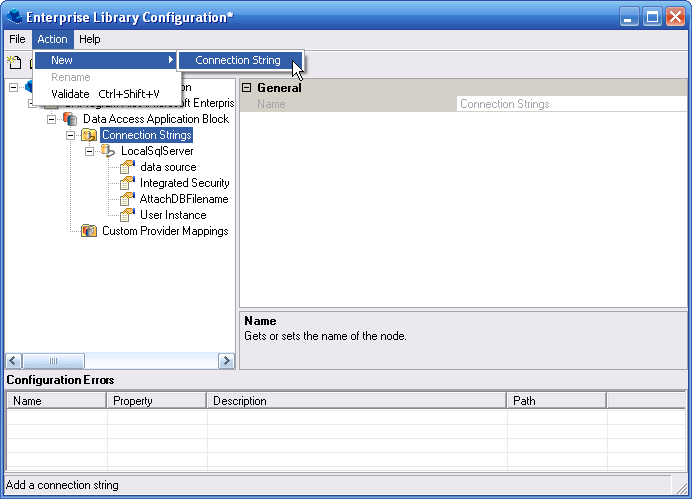
B.选择 the Data Access Application Block | Connection Strings | Connection String node. Change the Name property to QuickStarts Instance.
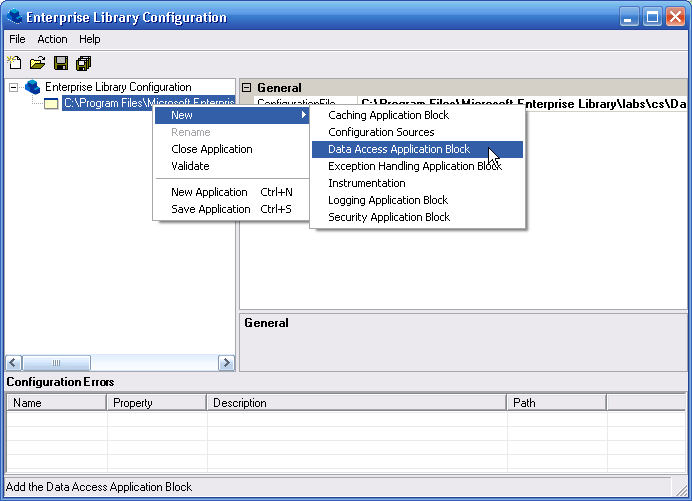
C.Select the Database node for this connection string. Change the Value property on the right hand side to EntLibQuickStarts.
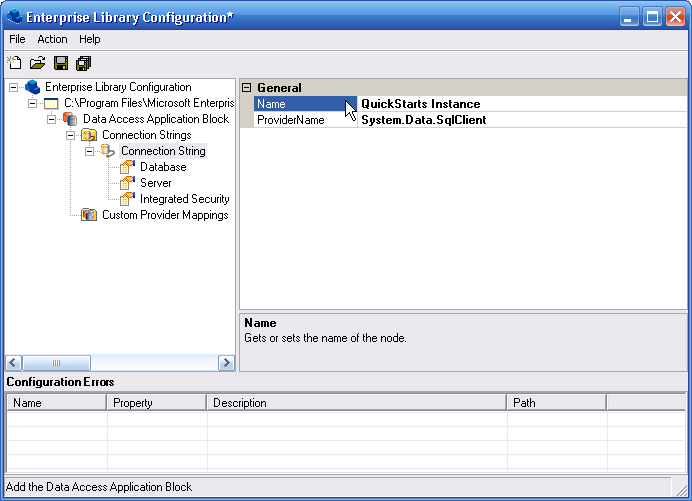
D.选择 the Server node, and set its Value to "(local)\SQLEXPRESS".
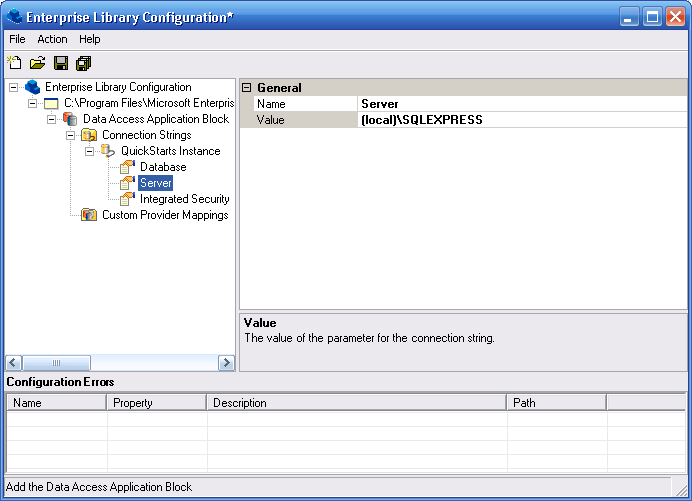
E.Select the Data Access Application Block node. Set the DefaultDatabase property is to the QuickStarts Instance. Then, save it.

参考资料
Download Enterprise Library and related resources from:
http://msdn.microsoft.com/practices
http://msdn.microsoft.com/library/?url=/library/en-us/dnpag2/html/EntLib2.asp
Join the
http://practices.gotdotnet.com/projects/entlib
Read blogs from the Enterprise Library team at:
posted on 2006-07-03 10:05 mjgforever 阅读(4086) 评论(1) 收藏 举报







 浙公网安备 33010602011771号
浙公网安备 33010602011771号